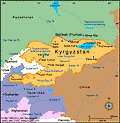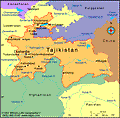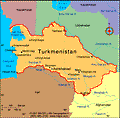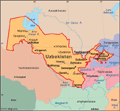Guide to New Nations: Kazakhstan, Kyrgyzstan, Tajikistan, Turkmenistan, Uzbekistan

Central Asia
by David Johnson |
| Kazakhstan "Land of the Kazaks," Kazakhstan declared its sovereignty on October 25, 1990, but became independent on December 16, 1991. Soon after the former Soviet republic joined the Commonwealth of Independent States. It has since relinquished nuclear weapons stored on its territory under the Soviet Union. The capital moved to Aqmola (also known as Astana) from Almaty in 1998. The second largest former Soviet republic in size, Kazakhstan has vast agricultural potential. It also possesses sizable reserves of oil and minerals. Since 1995 it has begun privatization of the economy. |  Kazakhstan Flag |
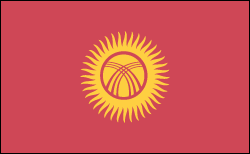 | Kyrgyzstan Kyrgyzstan, or "Land of the Kyrgyz" was the Kirghiz Soviet Socialist Republic until August 31, 1991. A member of the Commonwealth of Independent States, the new nation joined the U. N. and the International Monetary Fund in 1992. Kyrgyzstan also adopted a strong free market reform program. In 1996, Kyrgyzstan, China, Russia, and Kazakhstan signed a non-aggression treaty. Kyrgyzstan is also increasingly concerned about the illegal drug trade across its borders. |
| Tajikistan The Tajik Soviet Socialist Republic became Tajikistan, "Land of the Tajiks," on September 9, 1991 and joined the Commonwealth of Independent States. Since independence, Tajikistan has had three changes of government and a civil war. Islamic fundamentalists and democratic opposition groups battled the Communist-led authoritarian government. In 1997 the government and a coalition of Islamic organizations signed a peace agreement. Despite the presence of a Russian-led peacekeeping force stationed throughout the country, and Russian guards along Tajikistan's border with Afghanistan, violence erupts periodically. | 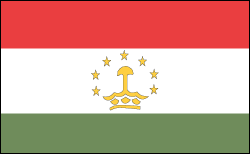 Tajikistan Flag |
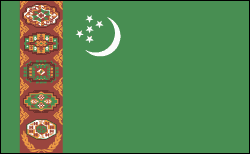 | Turkmenistan A former Soviet republic, Turkmenistan, "Land of the Turkmen" became independent on October 27, 1991. It subsequently joined the Commonwealth of Independent States. A constitution was adopted in May 1992. However, the government of Turkmenistan is more authoritarian than those of other new Central Asian nations. President Saparmurad A. Niyazov, was named President-for-life in 2000. Also called the Turkmenbashy "Leader of All Turkmens," he has sought to create a cult of personality. Although it contains vast quantities of natural gas, and borders the Caspian Sea, site of sizable oil deposits, Turkmenistan remains a poor nation. In 1993 Russia shut down a gas pipeline running through its territory because it competed with its own gas industry. Since then, Turkmenistan has used a gas pipeline running through Iran. |
| Uzbekistan "Land of the Uzbeks," Uzbekistan became independent on August 31, 1991. A former Soviet republic, Uzbekistan soon joined the Commonwealth of Independent States. While the government affirms its commitment to democracy and human rights, opposition political parties are suppressed. One of the poorest areas of the former Soviet Union, Uzbekistan relies heavily on agricultural crops. It is the world's third largest cotton producer. | 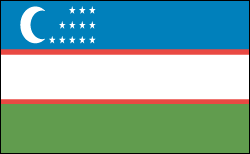 Uzbekistan Flag |

